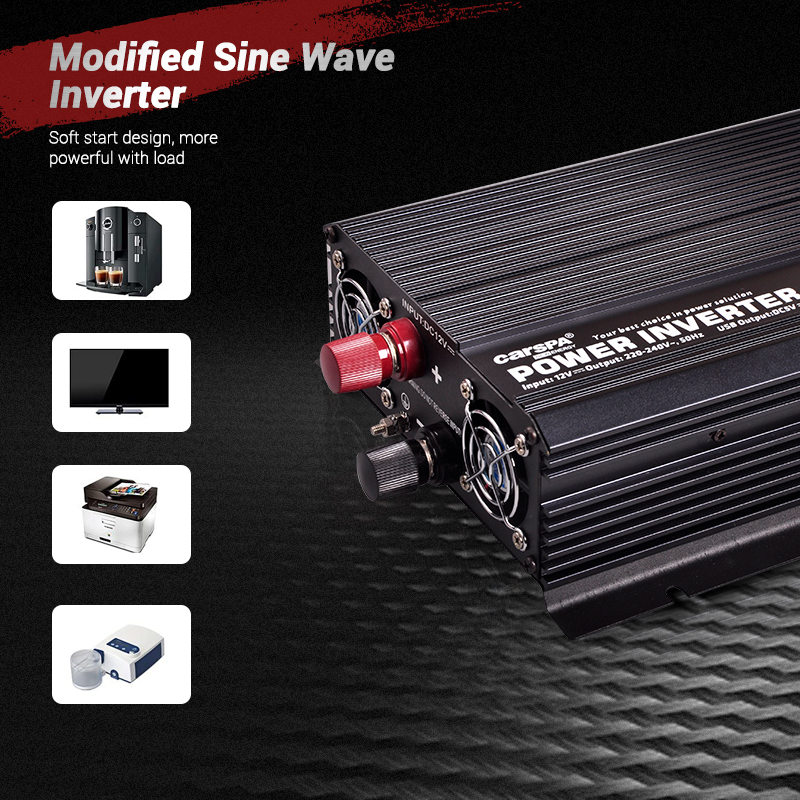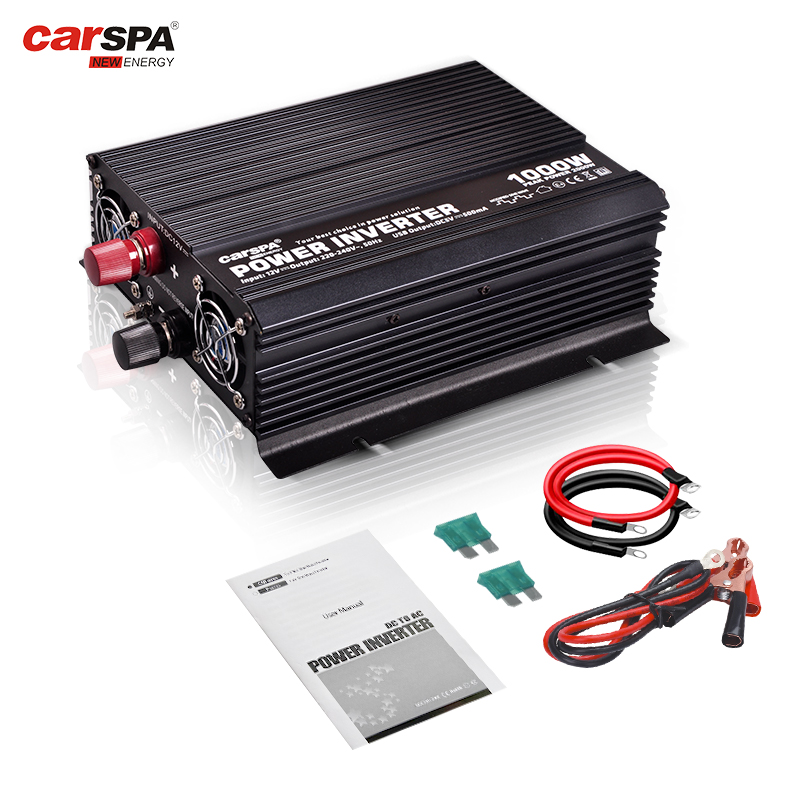How to calculate how long a 12V battery will last with a 1000W power inverter?
In our daily life, especially in scenarios such as off-grid power systems, outdoor activities, and emergency backup power, it is very important to know how long a 12V battery can run continuously with a 1000W power inverter. This article will explore in depth how to accurately calculate the battery's operating time and analyze various influencing factors in detail to ensure that the most reliable power support can be obtained in practical applications.
1. Basic principles and calculation formulas of batteries and inverters
In order to accurately estimate the battery's operating time, we first need to understand the working principles of 12V batteries and 1000-watt power inverters and master the relevant calculation formulas.
Basic characteristics of batteries
The two most important parameters of batteries are voltage (V) and capacity (Ah). The capacity of a battery indicates the amount of power that the battery can provide, usually in ampere hours (Ah). The total capacity (Wh) of a battery, that is, the amount of energy that a battery can provide, can be calculated using the following formula:
Total capacity (Wh) = voltage (V) × capacity (Ah)
For example, a 200Ah 12V battery has a total capacity of:
2400Wh = 12V × 200Ah
This means that, ideally, the battery can provide 2400 watt-hours of energy, which can be used to drive a variety of electrical devices.
Function and efficiency of inverters
The main function of an inverter is to convert direct current (DC) into alternating current (AC), allowing the battery to power common household appliances. The efficiency of an inverter is an important indicator of its energy conversion capability, usually expressed as a percentage. Assuming an inverter has an efficiency of 90%, it means that it converts 90% of the DC power into AC, and 10% of the energy is lost as heat during the conversion process.
The power of an inverter is usually expressed in watts (W), such as a 1000 watt power inverter that has a maximum power output of 1000 watts. In practical applications, the efficiency of the inverter has a direct impact on the battery's operating time.
2. How to calculate the operating time of a 12 volt battery with a 1000W power inverter
To calculate the continuous operating time of a 12V battery when paired with a 1000W inverter, we can use the following formula:
Operation time (hours) = total power (Wh) × inverter efficiency / inverter power (W)
Simplified as:
t=E×η/P
Where:
t represents the operating time (hours)
E represents the total power of the battery (Wh)
η represents the efficiency of the inverter (expressed as a decimal)
P represents the power of the inverter (W)
Actual calculation example
Assuming there is a 12V 200Ah battery with a total power of 2400Wh, paired with a 1000W power inverter(or RV inverter) with an efficiency of 90%, the operating time is calculated as follows:
t= 2400×0.90/1000
t= 2160/1000=2.16 hours
This result shows that, ideally, if the inverter continuously outputs 1000W of power, the battery will be able to support about 2.16 hours.
However, this calculation result is based on theoretical values, and there are many other factors that affect the battery's runtime in actual applications. Next, we will analyze these factors in depth and explore how to extend the actual battery runtime by adjusting the system configuration.
3. Other factors affecting runtime
Although the theoretical runtime can be obtained through the above formula, in actual use, there are many factors that affect the actual battery life. Understanding and considering these factors is very important for accurately estimating the actual battery runtime and optimizing the power system.
Actual power of the load
The output power of the inverter is not always maintained at its maximum rated power of 1000W. The lower the actual load power, the longer the battery runtime.
Let's recalculate the battery runtime under different load conditions.
For example, if the load is 500W instead of 1000W, the runtime will increase.
We can use the same formula to calculate:
t= 2400×0.90/500=4.32 hours
This shows that the battery's operating time will double when the load power is halved.
Battery health and usage environment
The battery's health has a direct impact on its actual capacity. As the battery's usage time increases, its effective capacity will gradually decrease. For example, an aging battery may only provide 80% of its nominal capacity, which will directly shorten the battery's operating time. In addition, the usage environment also has a significant impact on battery performance. Extreme temperatures (overheating or overcooling) may cause the battery efficiency to decrease and may even cause the battery to fail to work properly.
For example, in a low temperature environment, the battery's capacity may decrease by 30% or more, resulting in a significant reduction in battery life. Therefore, in cold weather conditions, the actual battery runtime may be significantly lower than the theoretical calculated value. In this case, users should consider using or storing the battery in a warm environment, or provide appropriate insulation measures for the battery.
Actual efficiency of the inverter
The efficiency of the inverter usually varies depending on factors such as the working environment and load size. Typically, an inverter is most efficient when it is close to its maximum load, but the efficiency may decrease at low loads. This means that if the inverter is not running at full load, it may consume more power, thereby reducing the battery's operating time.
Assuming that the actual efficiency of the inverter drops to 80%, the operating time will become:
t= 2400×0.80/1000=1.92 hours
This calculation shows that the reduction in inverter efficiency will directly shorten the battery's operating time. Therefore, in practical applications, users should pay attention to the operating efficiency of the inverter and choose a high-efficiency inverter as much as possible to extend the battery's operating time.
Impact of other devices and loads
In some systems, in addition to the power inverter and the main load, there may be other devices that need to consume power. For example, chargers, controllers, or monitoring systems. These devices will consume additional battery power, thereby shortening the total operating time of the system. Especially in some complex power supply systems, this additional power consumption may have a significant impact on battery life.
To calculate the impact of these additional devices, you can add their power requirements to the total power and then recalculate the total run time. For example, if there is an additional 100W of power consumption in the system, the total power will increase to 1100W:
t= 2400×0.90/1100=1.96 hours
With this method, users can more accurately estimate the actual battery run time and make adjustments based on actual conditions.
4. How to optimize the system to extend the battery run time
After understanding the various factors that affect the battery run time, you need to consider how to optimize the system to extend the battery run time. This is especially important for ensuring continuous power supply in situations where resources are limited, such as long outdoor activities or emergency situations.
Choose an efficient inverter
Choosing an efficient inverter is the key to extending battery life. The higher the efficiency of the inverter, the greater the proportion of the battery's energy converted into actual usable AC power, thereby extending the battery run time. When selecting an inverter, you should check its efficiency curve under different loads and choose an inverter that can maintain high efficiency within the commonly used load range.
For example, if an inverter has an efficiency of more than 90% at 50%-100% load, it means that it can provide efficient energy conversion for the system in most actual use cases, thereby optimizing the battery life.
Regular battery maintenance
Maintaining the health of the battery is a basic requirement to ensure its maximum capacity and optimal performance. Regularly check the battery's voltage, capacity and internal resistance to ensure that it is in good condition. For lead-acid batteries, regular hydration and maintenance are necessary, while lithium batteries need to be careful to avoid overcharging and deep discharge.
Regular maintenance not only prolongs the life of the battery, but also ensures that the battery can provide stable output when in use. When not in use for a long time, it is recommended to fully charge the battery and store it in a cool and dry place to reduce battery self-discharge and deterioration.
Optimize load management
By optimizing load management, unnecessary power consumption can be reduced, thereby extending the battery's operating time. For example, the working time of the load can be adjusted according to actual needs to avoid running high-power equipment when the battery is low. In addition, when possible, use more energy-efficient equipment or transfer some non-essential loads to other power sources.
In actual operation, users can use intelligent load management systems to automatically adjust the start and stop time of the load to optimize power distribution and maximize the battery life.
Using backup power
In situations where long-term power demand is high, you can consider using multiple batteries or backup power to extend the system's power supply time. For example, use solar panels to charge the battery, or use a second battery as a backup power source to ensure the continuity of power supply after long-term use.
In addition, using a portable generator or wind power generation system as an auxiliary power source is also an effective solution. By combining multiple power sources, you can ensure continuous power supply in various environments.
Conclusion
Calculating the operating time of a 12V battery with a 1000W power inverter requires comprehensive consideration of multiple factors, including the capacity of the battery, the efficiency of the inverter, the size of the actual load, and the health and use environment of the battery. By understanding these basic concepts and formulas, users can accurately estimate the system's battery life and take effective measures in actual applications to optimize system performance and extend the battery's operating time. In daily life, outdoor activities and emergency situations, it is an important skill that every power system user needs to master to reasonably plan and manage the power system to ensure the continuity and reliability of power supply.









